|
The automatic accompaniment of this instrument plays in fingered chord
mode when 2 chord section keys are pressed the same simple pattern like
when only 1 key is pressed; as well the HBATEC as the Letron
MC-3 play here a duet pattern instead. Unlike the HBATEC, with rhythm
off the "fingered" and "single finger" buttons don't enable an organ chord
mode despite their LED is lit. Instead of the "manual bass" button there
is an "arpeggio" button; the arpeggio pattern is mixed into the main voice
and thus can be also played without rhythm and accompaniment by simply
setting these volume faders to zero. The arpeggio uses a slightly different
(less cheesy) style than the arpeggio easteregg I found on my HBATEC, and
its sound also employs here a slow decay envelope. The rhythm tempo can
be set even yet another step higher than the already tremendously fast
one of the HBATEC, which turns it fully into a rapidly purring drumroll;
especially in combination with arpeggio this provides the famous fast arpeggiator
patterns known from C64 homecomputer SID music.
circuit bending detailsThe Fujitone 3-A hardware is based on the Angletone DM-380 CPU "ANGELTONE KZ381" (40 pin DIL, crystal clocked @ 7.7 MHz).I am not sure if this was a predecessor or successor of the HBATEC, because while the existence of an arpeggio and inferior features normally hints to an older version, this instrument is otherwise based on a strange no-name 40 pin CPU, while the HBATEC had the "KZ 283" by the brand quality manufacturer Zilog, which only 28 pins demanded a complex keyboard matrix scan technique. The yellow box of my Fujitone 3-A shows a photo of an instrument with the same case but no brand label and button names corresponding to my Letron MC-3 (but without its many LEDs), which is a digital and technically more modern instrument that apparently either got finished later or was imitated by mysterious reasons using costlier analogue hardware. Strange is also that Fujitone 3-A is the only mono instrument of this series despite it has a "stereo" label, and the writings are slightly different; e.g. there is nowhere the term "custom drummer" on it. Also the sustain function (i.e. transistorized flipflop) is missing. Most plausible to me appears a cheapened HBATEC successor that was made before the actual MC-3 when a brandless cheap 40 pin CPU (Zilog clone) became available.
keyboard matrix
The input lines are active-low, i.e. react on GND. Any functions can
be triggered by a non- locking switch in series to a diode from an "in"
to an "out" pin. The matrix was sorted by ascending key notes.
eastereggs:
LED from any other pin among this group flashes with the percussion: to KO6 = hihat open
Keyboards without analogue percussion circuit play only accompaniment; they do this even (in fixed key) with accompaniment turned "off". I haven't figured out how the CPU detects the lack of percussion hardware to start accompaniment always. It is no fixed matrix diode. Possibly it finds the envelope capacitors in the matrix by timing differences (similar like a C64 paddle port). Due to similar analogue circuits, there are certainly similar mods possible
like with my HBATEC keyboard.
pinout KZ381 & KZ281The "ANGELTONE KZ381" (40 pin DIL) is a squarewave home keyboard CPU with 2 note polyphonic main voice and accompaniment. CPU "ANGELTONE KZ281" (found in Angletone DM-100) seems identical. It was apparently a direct successor of the KZ283 in the HBATEC keyboard, but has 40 pins to support a conventional keyboard matrix. The 2 main voice channels have analogue capacitor envelopes controlled through each a short envelope trigger pulse /ME and an inverted analogue envelope shape signal /MS. Unlike KZ283, there is no manual chord mode and arpeggio is output through the 2nd main voice channel (which stays mute with accompaniment). Pin 9 outputs something that looks like the clock divided by 2. Pin 10 combined with the keyboard matrix outs can control LEDs and 5 percussion triggers. Pin 28 stays hi when accompaniment is on. I found no difference between KZ381 and KZ281. Possibly the 281 is a 381 with a software bug (custom drummer mode locked up sometimes during my tests?) and so was used for percussionless versions.Although there is no Zilog brand anywhere, conclusions from predecessors and pinout comparison with the "Zilog - Z8® Family Design Handbook" of June 1988 strongly hint that it is one of the following: Z8601 MCU (2KB ROM, 128 byte RAM, 12.5MHz, NMOS)
The analogue envelope shape is likely result of external capacitors,
since this MCU only supports digital signals. But despite +5V supply, I
measured only about +3V hi level at various pins. This pinout is based
on my own hardware observation combined with above MCU. Line names were
chosen by me to describe their functions (partly inspired by Casio naming
conventions).
The pinout is very different from the quite similar KZ282 (Z86C40 MCU) used in toy keyboards. Perhaps Angeltone changed the underlying CPU type because the latter had fixed input-only and output-only ports those restricted PCB layout design. |
attention: On eBay I saw later a version with type label "Fujitone 3A" (note the missing hyphen) that case (and button writing) looked very much like the photo on my Fujitone 3-A box (but with printed model name on the case), thus this seems to be yet another different instrument that likely contains just plain ordinary MC-3 hardware like the Fujitone 3. The same MC-3 thing was also released as Angeltone DM-280 (in a black nylon bag with red "ANGELTONE" logo, seen on eBay). Few DM-280 even contain actual Fujitone 3-A hardware (by button names - thanks Traktor for info); like the real Fujitone 3-A they seems to be extremely rare.
Likely a fullsize variant of Elta KE-3 in Fujitone 3-A case without drumpads and 'rec' & 'play' instead of custom drummer 'play/space' & 'program' buttons was released by Hua Li (only 2 Chinese characters) as DM-250. (Box shows brand "discover MTC" and "MusiTech Collection" with an MC-3 case (dummy?) MusiTech MT-4000, seen on internet.) I expect this to have a KZ282 CPU due to the sequencer buttons. Due to omitted drumpads it likely lacks percussion hardware.

This seems to be the original brand instrument of the Fujitone 3-A hardware class (see there), because case and CPU are both labelled Angeltone, and in comparison to the Fujitone 3-A it has many additional features those make almost full use of its keyboard matrix. The case of the DM-380 looks more elegant and moderner than the 3-A, and its smooth, bulged plastic drumpads are wonderful responsive. (It has some style elements common with the Hing Hon EK-001.) Unfortunately the volume controls work lousy and should be upgraded.
The Angeltone DM-380 was one of the last genuine analogue keyboards not specially designed for analogue synth enthusiasts. On German eBay around 2005 it was very common (although often fraudulently advertised with an absurdly high 'original retail price'), but nowadays they are all fairly rare, although not expensive. Thus if you don't own a variant of this hardware class yet, do not miss the occasion to buy one cheaply, because this tablehooter has programmable rhythm with fully analogue percussion (much like HBATEC) that doesn't sound bad. They sound somewhat brighter than with HBATEC/ Fujitone 3-A and IMO even a bit more natural. Annoying is only the strong static key matrix buzz that can not be turned off.
 |
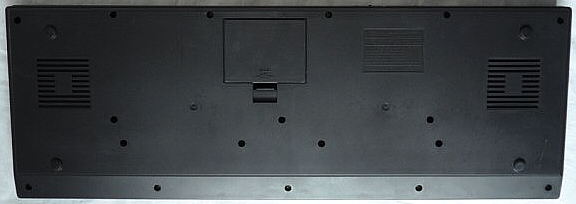 |
 |
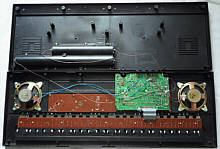 |
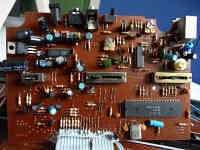 |
On the main PCB there are 3 trimmer pots for 2 tom and the cymbal/ snare decay envelope of the analogue percussion, but only the latter can be accessed from the back. The PCB is a really lousy mess of bad solder joints, bridges, patched wires and possibly recycled junk components that looks like assembled somewhere in a Chinese concentration camp.
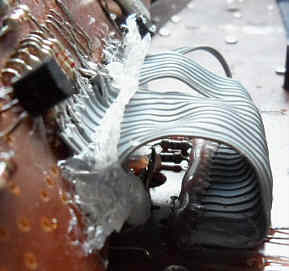 warning:
The ribbon cables at the PCBs are brittle and crack off very easy
when bent at their solder joints, thus do not attempt to remove the PCBs
unless you have prior hotglued all ribbon cable joints firmly to their
PCBs. I broke mine when I attempted to examine the PCB component side,
and it took many hours to re-solder these awful things. I soldered the
ribbon cables now to component wires on the solder side of the PCB, where
damages can be seen and repaired much easier. Also the tiny Y-C switch
tends to catch and break apart when pulling the PCB out (took hours to
fix) and the rectangular LED is a bit delicate to put back into its hole.
warning:
The ribbon cables at the PCBs are brittle and crack off very easy
when bent at their solder joints, thus do not attempt to remove the PCBs
unless you have prior hotglued all ribbon cable joints firmly to their
PCBs. I broke mine when I attempted to examine the PCB component side,
and it took many hours to re-solder these awful things. I soldered the
ribbon cables now to component wires on the solder side of the PCB, where
damages can be seen and repaired much easier. Also the tiny Y-C switch
tends to catch and break apart when pulling the PCB out (took hours to
fix) and the rectangular LED is a bit delicate to put back into its hole.
A very bizarre feature is that this instrument has a tiny slide switch "Y-C" at the back (that very easily falls apart when accidentally bent during PCB removal) to switch the single finger accompaniment between 2 different sets of chord patterns (i.e. the same key combinations select different chords). I likely would never have figured this out as a keyboard matrix easteregg without manual. Likely the "Y" and "C" genuinely stand for "Yamaha" and "Casio" single finger chord system, but the manufacturer avoided to mention these to prevent legal brand name or copyright problems. (But I doubt that the key presses to select chords are anything still copyrightable or patentable, and a decent formulation in the manual like "inspired by [brand]" or "like used by [brand] keyboard players" would be certainly sufficient to avoid legal trouble. E.g. the shortcut schemes of word processors are also switchable to emulate others without legal problems, since everything else would result in undemandable monopolies when all secretaries or musicians in the world would be forced to re-learn typing each time before they can use a different brand product.)
Because it is so unobvious, here is a (slightly
cleaned up) quote from the manual what the Y-C switch does:
| Single automatic bass chord playing method:
Press single automatic bass chord button (S. FINGER) it enters into the single automatic bass chord accompany state, Y single finger automatic bass chord playing method or C single finger automatic bass chord playing method, it can be selected by moving the C-Y switch. Y system of single finger automatic chord playing method: [this
would be Yamaha]
C system of single finger automatic chord playing method: [this
would be Casio]
|
There are also 2 different OBS arpeggios on this instrument and 16 OBS rhythms while the Fujitone 3-A has only 8 (rest as eastereggs). Most rhythms are like HBATEC; only the "slow rock" is very different, and the "16 beat" here has an annoying snare staccato.
Apparently a predecessor of the DM-380 was the Angeltone DM-450 (aka Fujitone 4-B, seen on eBay), which likely contained the same hardware (same OBS rhythm and sound names), but had a less stylish case with different button layout (2 grey rows for sound & rhythm presets) and blue drumpads (shaped like with Casio SK-8) at the upper right control panel rim.
The case of the Karcher F2 looks like the DM-380 except that it has no drumpads and thus no custom drummer section. Instead of the "program" and "play/ space" buttons it has 2 additional demo buttons (5 in total) although the buttons 4 and 5 are fake doublets and do the same like button 1 and 2. Next to the buttons are even 2 embossed fake LED shapes where the DM-380 has genuine LEDs.
 |
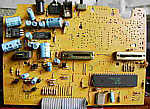 Theoretically
it would be likely possible to upgrade the F2 PCB with real analogue
percussion (solder holes are still there), but it would be a lot of work
and I haven't analyzed this further. Theoretically
it would be likely possible to upgrade the F2 PCB with real analogue
percussion (solder holes are still there), but it would be a lot of work
and I haven't analyzed this further. |
The DM-100 seems to be extremely rare. (I never saw another.) The wedge shaped case resembles Bestar MC3300.
 |
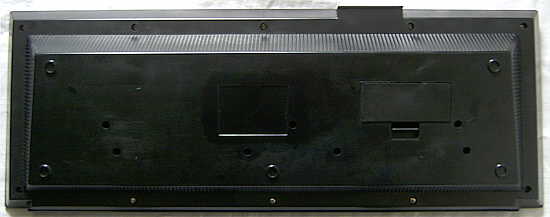 |
 |
 |
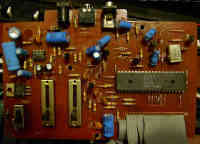 Unlike
Karcher F2, the PCB is much smaller and was never designed to have analogue
percussion. The keys PCB has the manufacturer name "ANDA ELECTRONIC LTD.",
which may be the same company like Xin Anda - creator of the absurd
8-Melody
Letter Study Piano. Very strange is that the CPU type is "ANGELTONE
KZ 281, 2163, 2 9127", not KZ
381 despite identical pinout and behaviour. Possibly it had a software
bug (custom drummer mode locks up sometimes?) and so was used for a percussionless
cheapo version. "2163" may allude to Yamaha YM2163
although none was installed. Unlike
Karcher F2, the PCB is much smaller and was never designed to have analogue
percussion. The keys PCB has the manufacturer name "ANDA ELECTRONIC LTD.",
which may be the same company like Xin Anda - creator of the absurd
8-Melody
Letter Study Piano. Very strange is that the CPU type is "ANGELTONE
KZ 281, 2163, 2 9127", not KZ
381 despite identical pinout and behaviour. Possibly it had a software
bug (custom drummer mode locks up sometimes?) and so was used for a percussionless
cheapo version. "2163" may allude to Yamaha YM2163
although none was installed. |
| removal of these screws voids warranty... | ||
 |
||
|
|